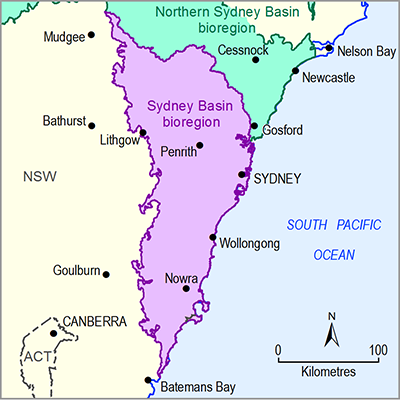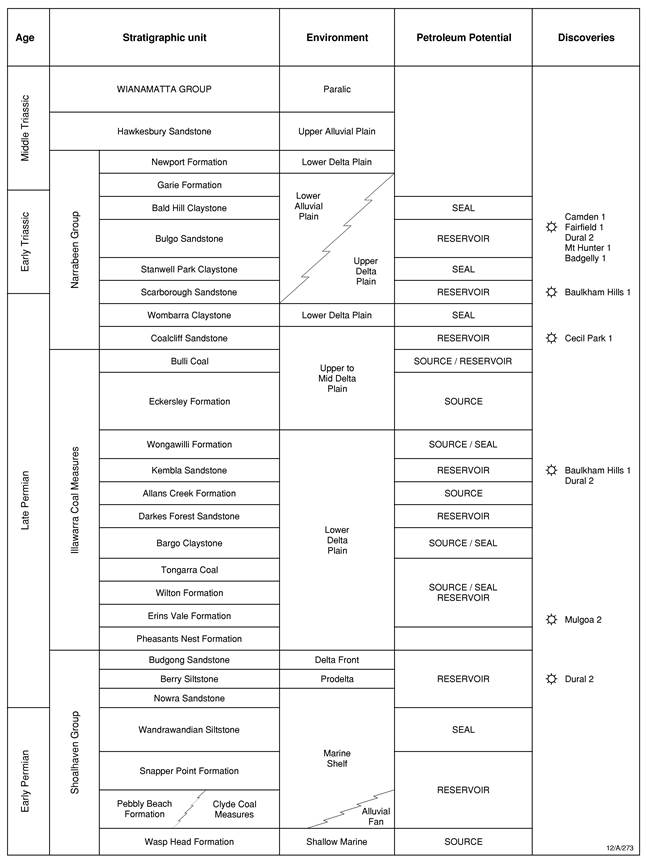The following is a brief summary of the coal and hydrocarbon resources of the onshore Sydney Basin bioregion. For a more in-depth description of these resources, see Section 1.2.1 of companion product 1.2 for the Sydney Basin bioregion (Hodgkinson et al., 2018).
1.1.3.4.1 Coal
The SGBB is a globally significant sedimentary basin for coal (Ward and Kelly, 2013). Coal was first discovered in the Sydney Basin in 1797 (Ward et al., 2014) and the Sydney Basin is now classed as one of Australia’s main coal provinces (Philp and Saxby, 1980; Brakel, 1991, p. 10). The Coalfield Geology Council of NSW divides the basin into five constituent coalfields, namely the Newcastle, Hunter, Western, Central and Southern coalfields (Figure 23; Saghafi et al., 2007; Ward and Kelly, 2013). The Southern Coalfield was previously known by several names, including the South-western Coalfield, the Southern Coalfield and the Clyde River Coalfield (Brakel, 1991, p. 11). The current Hunter and Newcastle coalfields were also previously termed the Northern Coalfield (Brakel, 1991, p. 10). The net volume of coal is greatest within the Hunter, Newcastle and Southern coalfields, specifically in the lower and upper Permian Greta, Tomago, Wittingham, Newcastle and Illawarra coal measures (Scott and Hamilton, 2006; Ward and Kelly, 2013). All economic coals within the Sydney Basin are Permian in age and are generally of medium to high volatile bituminous rank (Saghafi et al., 2007).
Across the entire Sydney Basin, most coals have reached the stage of thermal maturation suitable for gas formation (Scott and Hamilton, 2006; Ward and Kelly, 2013). The known gas content has been found to increase with increasing depth from surface (Ward and Kelly, 2013). Although a large proportion of gas contained within Sydney Basin coals is methane-rich, there are some areas that are rich in carbon dioxide or other gases (Faiz et al., 2007; Herbert 1983b; Pinetown 2013; Ward and Kelly, 2013). Previous investigations (Faiz et al., 2007; Scott and Hamilton, 2006; Pinetown, 2013) have concluded that the variance in gas content is due to the effect of different maturation influences (thermogenic, biogenic and/or magmatic heat; Ward and Kelly, 2013).
Coal in the Southern Coalfield is utilised as a resource through both underground mining activities (Saghafi et al., 2007; Ward and Kelly, 2013) and CSG operations, with gas from coal also being extracted from the underground mining operations (Ward and Kelly, 2013). The Southern Coalfield is considered to have a high potential for CSG resources with the main phase of thermal gas generation having been reached (Scott and Hamilton, 2006; Ward and Kelly, 2013). The coal in the Southern Coalfield is considered to differ in rank from the other coalfields; it is classed as low to high volatile bituminous coal (Saghafi et al., 2007). The coal is buried to great depths in some regions of the basin where burial exceeds 300 m (Saghafi et al., 2007). Hutton (2009, p. 44) considers the only economic coals to be those of the Sydney Subgroup within the Illawarra Coal Measures, predominantly from the Bulli Coal, the Balgownie Coal Member, the Wongawilli Coal and the Tongarra Coal.
The work of Scott and Hamilton (2006) identified prospective CSG regions bordering the Western Coalfield, or within the coalfield to the very north-west (Ward and Kelly, 2013). Underground mining is the most common method of coal extraction (Brakel, 1991, p. 12) but some open-cut coal mines are present (Saghafi et al., 2007).
1.1.3.4.2 Conventional hydrocarbon potential
Exploration and discoveries
In the late 1800s coal-based drilling projects discovered natural gas flows (Cadman et al., 1998, p. 144). In 1910 the first petroleum exploration was undertaken; within 28 years a total of 14 petroleum exploration wells had been drilled in the Sydney Basin (Swarbrick and Morton, 1993, p. 29; Cadman et al., 1998, p. 144). These initial exploration wells all resulted in gaseous shows and one contained indications of oil (Adler, 1993, p. 29; Cadman et al., 1998, p. 144, p. 145). A single well drilled at the site of the Balmain Colliery in 1937, produced approximately 4300 m3/week of gas (Cadman et al., 1998, p. 145). However, no further deposits of economic significance were found (Adler, 1993, p. 29). All of the petroleum exploration in the early 1900s was undertaken based on interpretation of the surface geology (Cadman et al., 1998, p. 145).
In the 1950s a second round of petroleum exploration took place (Cadman et al., 1998, p. 145). Exploration efforts in the mid-1900s were aided by limited seismic reflection data (Cadman et al., 1998, p. 145). Seismic data acquisition across the basin has occurred since the 1960s but has been irregular and is not extensive (Cadman et al., 1998, p. 146). Between the 1950s and 1998, a total of 69 further exploration wells had been drilled in the search for conventional hydrocarbon resources (Cadman et al., 1998, p. 145). The majority of exploration wells resulted in gas shows and eight wells drilled into the Narrabeen Group resulted in measured flow rate for gas (Cadman et al., 1998, p. 145). Two wells discovered gas flow in the Illawarra Coal Measures and minor flow in the Shoalhaven Group (Cadman et al., 1998, p. 145). Following this, the Narrabeen Group was explored further in the Camden region, where flow rates were also recorded (Cadman et al., 1998, p. 145). Several oil shows have been noted from these early exploration efforts but no major discovery has been found (Cadman et al., 1998, p. 145) though oil is thought to be more prominent offshore. Most of these shows occurred in the north-eastern Sydney Basin (onshore; Cadman et al., 1998, p. 145). However many of these exploration wells did not penetrate to depths beyond the Triassic strata, leaving the older stratigraphy largely untested (Cadman et al., 1998, p. 145, 146).
Hydrocarbon systems
Source rocks and maturation
Total organic carbon (TOC) data point to the gas source rocks of the Sydney Basin being dominantly late Permian, principally the Tomago, Newcastle, Wittingham and Illawarra coal measures (Figure 30; Cadman et al., 1998, p. 147). These stratigraphic units have TOC values of around 20%, with a greater percentage of inertinite than other macerals (Cadman et al., 1998, p. 147). The Greta Coal Measures (Figure 30) also have significant exinite maceral counts, indicating oil potential (Cadman et al., 1998, p. 147). Cadman et al. (1998, p. 147) stated that in addition to the coal measures, the marine incursions of the late Permian may also hold potential for oil. The Lower Triassic shales of the Narrabeen Group are considered the likely source of gas within the Narrabeen Reservoir (Figure 30; Cadman et al., 1998, p. 148).
The absence of Jurassic strata (due to erosion) means that precise thermal modelling is not possible. However, it is likely that the lower Permian source rocks (Greta Coal Measures) of the Sydney Basin reached thermal maturity during the Triassic through to the Jurassic (Cadman et al., 1998, p. 148). The late Permian source rocks (Tomago, Newcastle, Wittingham and Illawarra Coal Measures) were in the thermal maturity window from the Upper Jurassic (Cadman et al., 1998, p. 148). The Lower Triassic source rocks (Narrabeen Group) within major depocentres reached thermal maturity during the middle Cretaceous (Cadman et al., 1998, p. 148). Geoscience Australia (2015a) state that the generation of hydrocarbons is still in progress.
Reservoirs and seals
Potential reservoirs have been identified within the Permian and Triassic stratigraphy of the Sydney Basin (Cadman et al., 1998, p. 146). The Narrabeen Group holds several potential reservoirs within its fluvial sandstones (Bulgo Sandstone, Scarborough Sandstone and Coal Cliff Sandstone; Figure 30) which are sealed by the fine-grained claystone deposits of a floodplain or lower delta plain (Bald Hill Claystone, Stanwell Park Claystone and Wombarra Claystone; Figure 30; Cadman et al., 1998, p. 146). The porosities of these reservoirs are variable and though clay overgrowths limit the pore space, porosity values of up to 20% are recorded in sandstone units (Cadman et al., 1998, p. 146). Due to the clay overgrowths, permeability is generally low (<10 millidarcies) resulting in moderately good reservoirs (Cadman et al., 1998, p. 146).
The Illawarra Coal Measures and the Shoalhaven Group (Figure 30) have been found to contain gas in several wells (Cadman et al., 1998, p. 146). While the potential reservoirs of the Illawarra Coal Measures are composed of suitable reservoir material, the permeability is low (Cadman et al., 1998, p. 146). The most permeable unit is a fluvial unit that has been reworked as a result of marine incursion, the Darkes Forest Sandstone (Figure 30; Cadman et al., 1998, p. 146, 147). Of the Shoalhaven Group the Muree, Nowra and Cessnock sandstones display good reservoir quality, while the Mulbring and Berry siltstones, along with the siltstone in the Branxton Formation, form potential seal units (Cadman et al., 1998, p. 147).
Traps and seals
Anticlinal and fault dependent closures formed during the Permo-Triassic compressional phase have produced structural traps for the hydrocarbons generated during the Triassic, sourced from lower Permian rocks (Cadman et al., 1998, p. 148). However there is the potential for oil reservoirs near the depocentres to have been flushed by later gas flow (Cadman et al., 1998, p. 148). Extension during the Late Cretaceous rifting resulted in the formation of fault-dependent and four-way-dip closures (Cadman et al., 1998, p. 148). These Late Cretaceous traps may lock in Permian and Triassic hydrocarbons (Cadman et al., 1998, p. 148). During the Paleogene and Neogene compression of the basin resulted in folding and faulting, but also the reactivation of existing structure (Cadman et al., 1998, p. 148). It is likely that the late compressional phase could have breached existing traps resulting in secondary migration (loss) of the hydrocarbons (Cadman et al., 1998, p. 148).
Figure 30 Potential petroleum systems of the southern Sydney Basin
Source: Cadman et al. (1998, p. 143)


